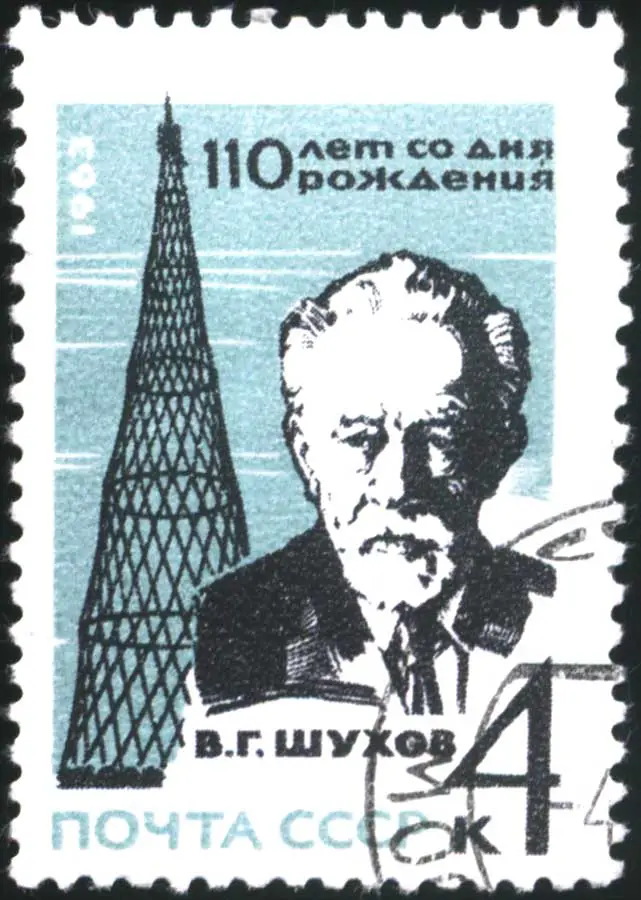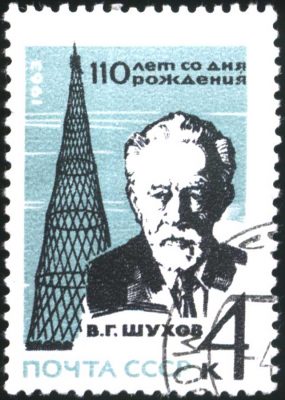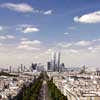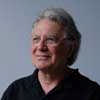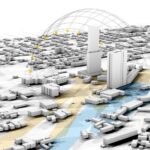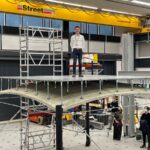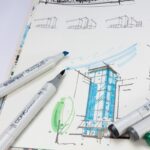Diagonal Building, Ian Ritchie Architect, Architecture Article, Design
Diagonal Architecture : Diagrid Structures
Architecture Discussion article by Ian Ritchie architect
13 Mar 2012
Diagonal Structures
I have been sent a ’mixed bag of projects’ upon which to reflect and write this editorial.
However, I have picked upon one evident theme – engineering and the expressive diagonal line. Sontag’s great book ‘On Photography’ was seminal in my caution in interpreting and critiquing architecture from images alone.
At Corbevoie we can see the expression of diagrid structure – a favourite of Foster and Partners. These towers offer, with many others, a family of uncertain semiological meaning.
They are very significant and expressive structures without necessarily justifying a naturally privileged focal point in the city. In other words they respond to commercial imperatives combined with a need for identity. Public spaces inside or outside provide the panacea to obtain permissions.
Earlier towers by Foster + Partners, such as the Deutsch Bank in Sydney (1997-2005) and the later proposed Dublin U2 Tower (2006) designs were very similar in height and form – suggesting that ‘you-too’ can have one, while the ‘Cheese Grater’ form of Roger’s London skyscraper designed in 2003 is another of this period.
These use the traditional diagonal bracing of an orthogonal structure associated with architectural expression dating from the 1960s. The departure towards an expressed ‘diagrid’ for Foster & Partners was probably the Gherkin (1997-2004).
The United Steel Workers’ Building in Pittsburgh, completed in 1963 by Curtis & Davis was the first exterior diagonal-grid load-bearing steel frame building constructed, with a steel wall, and supported on only eight expressed point foundations. It was engineered by John Skilling and Leslie Robertson. Skilling, as Worthington, Skilling, Helle & Jackson, engineered a framed ‘tube’ structure for the twin towers of New York’s World Trade Centre designed by Minoru Yamasaki.
Interestingly, apparently inspired by the NY metro use of express and local stations, they introduced the new concept of sky lobbies where people could switch from express lifts to local ones – minimising the amount of lift shaft space of the building’s core.
Completed in 1968, The Hancock tower was designed on the framed ‘tube’ structure advanced by Fazlur Kahn in 1963, a Bangladeshi American engineer working at SOM. The ‘tube’ concept is basically a hollow cantilever. The first examples used a lot of closely spaced vertical columns braced by deep moment-connected spandrel beams at each floor level – the now destroyed World Trade Towers being an example.
The origin of ‘diagonal’ structures is surely the Russian genius Vladimir Shukhov.
He pioneered new analytical methods in many different fields, and I have been fortunate to visit some of his constructed projects more than once. Shukhov left a lasting legacy to early Soviet Russia constructivism, and as the leading engineer and mathematician during the late 18th and early 19th century he created hyperboloid, thin shell and tensile structures of extraordinary refinement and elegance.
Most architects of my generation interested in structures came across the very first geodesic dome designed by Walter Bauersfeld, chief engineer of the Carl Zeiss optical company. It covered a planetarium whose starfield projection system was also designed by him. This dome was patented and opened to the public in Jena, Germany in July 1926.
They were then built in Rome, Paris, Chicago, LA and New York during the 1930s. Fuller is quoted as the seminal figure by most architects when it comes to triangulated structures, but he was not the inventor of the geodesic dome. He did popularise the name and market the idea – and did obtain a U.S. patent!
Previously, all drawings for these structures were created by engineers, which was a challenging and time-consuming process. These days, the active usage of software development services in architecture helps engineers reduce time for outlining standard lines and invest more time in creating marvelous structures for the cities.
What does the ‘diagrid’ present to us?
It is not a Brancusi ‘egg’, yet in one sense it makes buildable a tall continuous shell, which, as we know from the eggshell, works structurally in any direction. The ‘diagrid’ does so by triangulating the shell, the frequency of which depends largely upon the aesthetic desire of the architect, and the engineer. Engineers will say that it makes evident a highly efficient use of material, and the architect will argue the same for column-free interior space. Everything about the structure relies on the complex fabrication of the nodes.
I have often felt that the diagonal line is aggressive, unnatural, suggesting a restless kinetic energy. The curved line of an eggshell is everywhere in nature. Shukhov’s hyperboloid structures captured this beautifully.
The two ‘diagrid’ towers at Courbevoie also pick up on the prevailing form of providing ‘more on top’, and are set upon the ubiquitous plaza, this time as a fractured composition, reminiscent of a fashionable ground plan architectural approach of the early noughties.
The ‘more on top’ was perhaps started inadvertently by Spreckleson, the Danish architect who designed La Grande Arche de la Defense in 1982. (visible in the picture). It was envisaged at the time that this ‘window’ was to have its adjacent campanile. Now it is appears dwarfed when seen from the city centre looking west.
Are these ‘diagrid’ buildings refinements of internal and external spatial arrangements, responses to parametric modelling and analysis, pre-fabrication and economic construction method, or simply that old chestnut of exploiting commercial and ego opportunity through architectural image? We can see that transparent glass is still the answer to the answer that architecture is the answer, but what are the real questions?
There is a sense that the isolation of people in towers is the norm, that it is desired in an age where people choose to be isolated and live through virtual means believing that we communicate more while in fact we actually appear to engage less as human beings.
We seem to have a society that values shares more than it shares values.
The architect and engineer may talk of nature’s forms, of ecological imperatives answered by density (towers), yet we see more and more individual buildings marketed as a ‘city within a city’.
I see imitation’s opposite as innovation. Imitation is a business method that is used to catch up; and when imitated quickly, is often marketed as if it is ‘innovative’. Imitation is an excellent business method!
We know that imitation and even visual mimesis in architecture reflects this, while innovation usually requires significant investment as ideas take time to test and refine.
This is why developers do not innovate or lead, they rely on the image and the marketing language of architects to provide the ‘new’. This can work against those who are genuinely searching for better social or environmental solutions, or paradigm shifts in spatial organisation, environmental behaviour, or technical solutions.
Illustrating this very well is the example of ultra lightweight dynamic structural research from ILEK (Institute of Lightweight Structures and Conceptual Design) in Stuttgart. This city has been and remains the centre of Europe’s research and development in structures. Are there any architectural equivalents?
© Ian Ritchie 2012
Ian Ritchie
Ian Ritchie CBE RA, Director of Ian Ritchie Architects and Founding Director of RFR (Rice Francis Ritchie) design engineers, Paris. Royal Academy of Arts Professor of Architecture and visiting Professor at Liverpool University.
Location: 110 Three Colt Street, London E14 8AZ, England, UK
Ian Ritchie Links
Architecture Articles – Selection
Architecture Context Narrative : article by Trevor Tucker. 21 Sep 2010
Resisting Boredom : article by Joyce Hwang. 25 Jan 2011
Design Narrative : article by Lee Miles – 7 Sep 2010
Sustainable Buildings – Building Issues : article by Adrian Welch
Comments / photos for the Diagonal Architecture – Diagrid Structures Article page welcome

